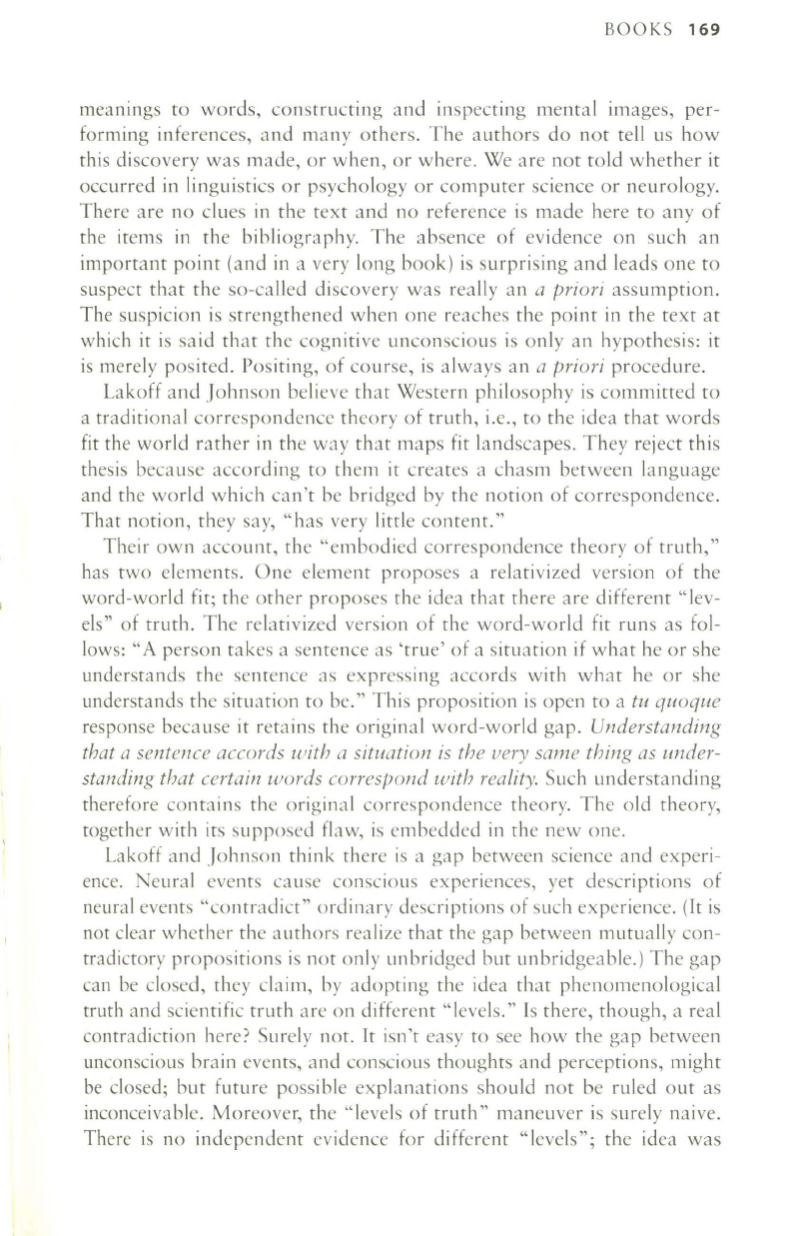
BOOKS
169
meanings to words, constructing and inspecting menta I images, per–
forming inferences, and many others. The authors do not tell us how
this discovery was made, or when, or where. We are not told whether it
occurred in linguistics or psychology or computer science or neurology.
There are no clues in the text and no reference is made here to any of
the items in the bibliography. The absence of evidence on such an
important point (and in a very long book) is surprising and leads one to
suspect that the so-called discovery was really an
a priori
assumption.
The suspicion is strengthened when one reaches the point in the text at
which it is said that the cognitive unconscious is only an hypothesis: it
is merely posited. Positing, of course, is always an
a priori
procedure.
Lakoff and Johnson believe that Western philosophy is committed to
a traditional correspondence theory of truth, i.e., to the idea that words
fit the world rather in the way that maps fit landscapes. They reject this
thesis because according to them it creates a chasm between language
and the world which can't be bridged by the notion of correspondence.
That notion, they say, "has very little content."
Their own account, the "embodied correspondence theory of truth,"
has two elements. One element proposes a relativized version of the
word-world fit; the other proposes the idea that there are different "lev–
els" of truth. The relativized version of the word-world fit runs as fol–
lows: "A person takes a sentence as 'true' of a situation if what he or she
understands the sentence as expressing accords with what he or she
understands the situation to be." This proposition is open to a
tu quoque
response because it retains the original word-world gap.
Understanding
that a sentence accords with a situation
is
the very same thing as under–
standing that certain words correspond with reality.
Such understanding
therefore contains the original correspondence theory. The old theory,
together with its supposed flaw, is embedded in the new one.
Lakoff and Johnson think there is a gap between science and experi–
ence. Neural events cause conscious experiences, yet descriptions of
neural events "contradict" ordinary descriptions of such experience.
(It
is
not clear whether the authors realize that the gap between mutually con–
tradictory propositions is not only unbridged but unbridgeable.) The gap
can be closed, they claim, by adopting the idea that phenomenological
truth and scientific truth are on different "levels." Is there, though, a real
contradiction here? Surely not.
It
isn't easy to see how the gap between
unconscious brain events, and conscious thoughts and perceptions, might
be closed; but future possible explanations should not be ruled out as
inconceivable. Moreover, the "levels of truth" maneuver is surely naive.
There is no independent evidence for different "levels"; the idea was


